
A review game in Jeopardy format for Science SOL 5.5 - sound.
- Subject:
- Force/Motion/Energy
- Material Type:
- Activity/Lab
- Author:
- Andrea Perry
- Date Added:
- 08/02/2022

A review game in Jeopardy format for Science SOL 5.5 - sound.

This lesson uses NASA satellite data to correlate cloud cover over Africa to the solar declination. The student will access NASA data using the MY NASA DATA Live Access Server and import the data into Excel spreadsheet software. Students will use NASA satellite data to correlate cloud cover over Africa to the solar declination.

Science Instructional Plans (SIPs) help teachers align instruction with the Science Standards of Learning (SOL) by providing examples of how the content and the scientific and engineering practices found in the SOL and curriculum framework can be presented to students in the classroom.
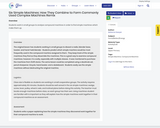
Students work in small groups to analyze compound machines in order to find simple machines which make them up.
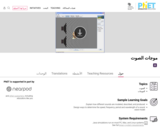
This simulation lets you see sound waves. Adjust the frequency or volume and you can see and hear how the wave changes. Move the listener around and hear what she hears.

Overall goal of the module (reference: The standards that reflect intended Enduring Understanding)The student will:A.) model a longitudinal (compression) wave and diagram, label, and describe the components (wavelength, compression, and frequency) (PS.6 a)B.) explain the relationship between frequency and wavelength (PS.6 a)C.) plan and conduct an investigation related to sound (the investigation may be a complete experimental design or may focus on systematic observation, description, measurement, and/or data collection and analysis) (PS.6 b)This module was developed by Tracey Nipper as part of a Virginia Commonwealth University STEM initiative sponsored by the Viginia Department of Education.

The student will compare sound traveling through a solid and sound traveling through the air. After the completion of this module students will understand that sound travels fastest through solids, slower in liquids and slowest through gas. This module was developed by Sarah Donnelly as part of a Virginia Commonwealth University STEM initiative sponsored by the Virginia Department of Education.
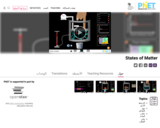
Watch different types of molecules form a solid, liquid, or gas. Add or remove heat and watch the phase change. Change the temperature or volume of a container and see a pressure-temperature diagram respond in real time. Relate the interaction potential to the forces between molecules.
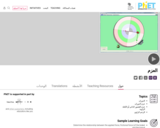
Investigate how torque causes an object to rotate. Discover the relationships between angular acceleration, moment of inertia, angular momentum and torque.


Lesson length: 1-2 hoursGrade level: 6-8This is a three part lesson where students (1) explore elements (and their properties) that are used in materials to build and power a cell phone (any easily accessed, small, electronic machine could stand in for a cell phone), (2) approach activities though an engineering design thinking lens and participate in an active simulation of the movement of electricity (electrons) to power a device, and (3) participate in a Lego build where they experience set constraints to their building project. This can be related to the constraints engineers face as they build cell phones (or anything else).This material is based upon work supported by the National Science Foundation under Grant No. 1657263. Any opinions, findings, and conclusions or recommendations expressed in this material are those of the author(s) and do not necessarily reflect the views of the National Science Foundation.
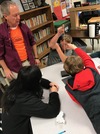
Lesson length: 1-2 hoursGrade level: 6-8Students use a recipe to create bouncy balls and then measure the bounce of their ball to test damping qualities of different materials. Students practice using the scientific method and think about how engineers might use it.This material is based upon work supported by the National Science Foundation under Grant No. 1657263. Any opinions, findings, and conclusions or recommendations expressed in this material are those of the author(s) and do not necessarily reflect the views of the National Science Foundation.
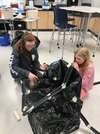
Lesson Length: 1-2 hoursGrade Level: 6-8Students learn about potential and kinetic energy as it relates to mountain roads. The activities are grounded in engineering design thinking as it relates to engineered roads and road repair. Also included is a challenge activity with renewable energy Snap Circuit simulations.This material is based upon work supported by the National Science Foundation under Grant No. 1657263. Any opinions, findings, and conclusions or recommendations expressed in this material are those of the author(s) and do not necessarily reflect the views of the National Science Foundation.
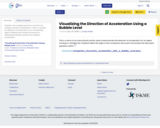
Students use a bubble level and a cart that can undergo constant acceleration in order to visualize the direction of acceleration for an accelerating object. Students then reverse the process to differentiate between positive and negative acceleration.
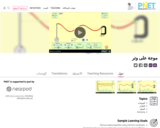
Watch a string vibrate in slow motion. Wiggle the end of the string and make waves, or adjust the frequency and amplitude of an oscillator. Adjust the damping and tension. The end can be fixed, loose, or open.
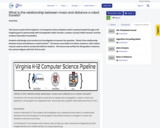
This lesson is part of the Virginia K-12 Computer Science Pipeline which is partly funded through a GO Virginia grant in partnership with Chesapeake Public Schools, Loudoun County Public Schools, and the Loudoun Education Foundation. Students will design and conduct an investigation to answer the question, "What is the relationship between mass and distance a robot travels?" The lesson uses WeDo 2.0 robots; however, other robots may be used as well as conducted without robotics. This lesson was written for 5th graders; however, the content alignes with SOL PS.8 as well.
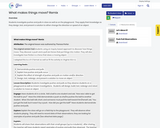
Students investigate pushes and pulls in class as well as on the playground. They apply their knowledge as they design, test, and present a solution to either change the direction or speed of an object.